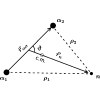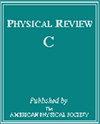Wave function of Be9 in the three-body (ααn) model
IF 3.4
2区 物理与天体物理
Q1 Physics and Astronomy
引用次数: 0
Abstract
A simple analytic expression of the three-body wave function describing the system in the ground state of is obtained. In doing this, it is assumed that the particles interact with each other via the -wave Ali-Bodmer potential including the Coulomb term, and the neutron- forces act only in the -wave state. This wave function is constructed by trial and error method via solving in this way a kind of inverse problem when the two-body potential is recovered from a postulated three-body wave function. As a result, the wave function is an exact solution of the corresponding three-body Schrödinger equation for experimentally known binding energy and for the potential whose difference from the Ali-Bodmer one is minimized by varying the adjustable parameters on which the postulated wave function depends.

三体(ααn)模型中 Be9 的波函数
我们得到了描述 Be9 基态 32- 系统 (ααn) 的三体波函数的简单解析表达式。在此过程中,假定 α 粒子通过包括库仑项在内的 S 波阿里-博德默势相互作用,而中子-α 力只作用于 P 波状态。这种波函数是通过试错法构建的,即从假定的三体波函数恢复二体 αα 势时,通过这种方法求解一种逆问题。因此,对于实验已知的结合能和αα势,波函数是相应的三体薛定谔方程的精确解,通过改变假定波函数所依赖的可调参数,可使其与αα势的差值最小化。
本文章由计算机程序翻译,如有差异,请以英文原文为准。
求助全文
约1分钟内获得全文
求助全文
来源期刊

Physical Review C
物理-物理:核物理
CiteScore
5.70
自引率
35.50%
发文量
0
审稿时长
1-2 weeks
期刊介绍:
Physical Review C (PRC) is a leading journal in theoretical and experimental nuclear physics, publishing more than two-thirds of the research literature in the field.
PRC covers experimental and theoretical results in all aspects of nuclear physics, including:
Nucleon-nucleon interaction, few-body systems
Nuclear structure
Nuclear reactions
Relativistic nuclear collisions
Hadronic physics and QCD
Electroweak interaction, symmetries
Nuclear astrophysics
 求助内容:
求助内容: 应助结果提醒方式:
应助结果提醒方式:


